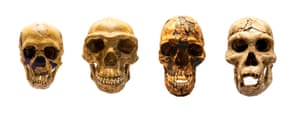article publié dans le "Guardian" du 13 juillet
Researchers say it is time to drop the idea that modern humans originated from a single population in a single location
The origins of our species have long been traced to east Africa, where the world’s oldest undisputed Homo sapiens fossils were discovered. About 300,000 years ago, the story went, a group of primitive humans there underwent a series of genetic and cultural shifts that set them on a unique evolutionary path that resulted in everyone alive today.
However, a team of prominent scientists is now calling for a rewriting of this traditional narrative, based on a comprehensive survey of fossil, archaeological and genetic evidence. Instead, the international team argue, the distinctive features that make us human emerged mosaic-like across different populations spanning the entire African continent. Only after tens or hundreds of thousands of years of interbreeding and cultural exchange between these semi-isolated groups, did the fully fledged modern human come into being.
Dr Eleanor Scerri, an archaeologist at Oxford University, who led the international research, said: “This single origin, single population view has stuck in people’s mind … but the way we’ve been thinking about it is too simplistic.”
This continental-wide view would help reconcile contradictory interpretations of early Homo sapiens fossils varying greatly in shape, scattered from South Africa (Florisbad) to Ethiopia (Omo Kibish) to Morocco (Jebel Irhoud).
The telltale characteristics of a modern human – globular brain case, a chin, a more delicate brow and a small face – seem to first appear in different places at different times. Previously, this has either been explained as evidence of a single, large population trekking around the continent en masse or by dismissing certain fossils as side-branches of the modern human lineage that just happened to have developed certain anatomical similarities.
The latest analysis suggests that this patchwork emergence of human traits can be explained by the existence of multiple populations that were periodically separated for millennia by rivers, deserts, forests and mountains before coming into contact again due to shifts in the climate. “These barriers created migration and contact opportunities for groups that may previously have been separated, and later fluctuation might have meant populations that mixed for a short while became isolated again,” said Scerri.
The trend towards more sophisticated stone tools, jewellery and cooking implements also supports the theory, according to the paper in the journal Trends in Ecology & Evolution.
Scerri assembled a multidisciplinary group to examine the archaeological, fossil, genetic and climate data together, with the aim of eliminating biases and assumptions. Previously, she said, scientific objectivity had been clouded by fierce competition between research groups each wanting their own discoveries to be given a prominent place on a linear evolutionary ladder leading to the present day. Disputes between rival teams working in South Africa and east Africa had become entrenched, she said.
“Someone finds a skull somewhere and that’s the source of humanity. Someone finds some tools somewhere, that’s the source of humanity,” she said, describing the latest approach as: “‘Let’s be inclusive and construct a model based on all the data we have available.”
The analysis also paints a picture of humans as a far more diverse collection of species and sub-populations than exists today. Between 200,000 and 400,000 years ago, our own ancestors lived alongside a primitive human species called Homo naledi, found in southern Africa, a larger brained species called Homo heidelbergensis in central Africa and perhaps myriad other humans yet to be discovered.

